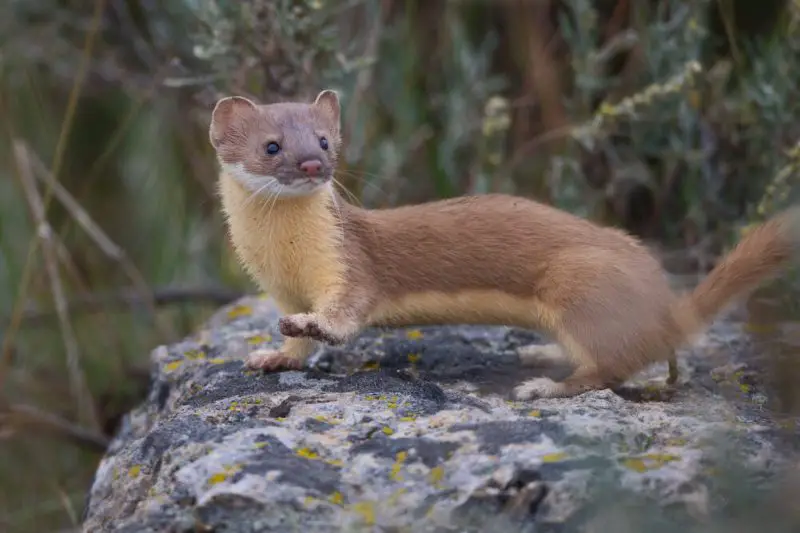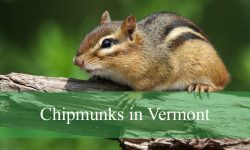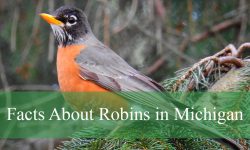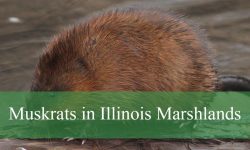In the quiet corners of Maine’s forests, where birch shadows fall over snow and streams wind through mossy rocks, a small predator slips unseen between the roots. Sleek, silent, and startlingly fierce, the weasel is one of the Pine Tree State’s most elusive residents.
You might catch only a flash — a narrow, russet body gliding like liquid through the underbrush or a snow-white streak darting over a drift. But behind that fleeting image lies one of nature’s most efficient hunters, a creature that has survived through cunning, agility, and instinct sharper than the chill of a Maine winter.
In this article, we’ll unveil the hidden world of Maine’s weasels — their species, habits, diet, winter transformations, and astonishing hunting behavior. You’ll discover how these pint-sized carnivores help maintain Maine’s ecological balance, and why their adaptability makes them one of the state’s most fascinating yet misunderstood animals.
Meet Maine’s Weasels

The Weasel Family in Maine
Maine is home to two primary weasel species: the short-tailed weasel (ermine or stoat, Mustela erminea) and the long-tailed weasel (Neogale frenata). Both belong to the mustelid family, which also includes mink, otters, martens, and fishers — all renowned for their sleek bodies and predatory prowess.
Though similar at a glance, these two species have distinct features. The short-tailed weasel is smaller, with a body about 7–13 inches long including its short, black-tipped tail. In contrast, the long-tailed weasel can reach up to 17 inches, its slender body built for lightning-fast pursuits through snow tunnels and underbrush.
Both species share a flexible spine, short legs, and a narrow skull — anatomical marvels that allow them to chase prey into burrows, hollow logs, and crevices where few predators dare to follow.
Distinctive Seasonal Transformations
Perhaps the most remarkable feature of Maine’s weasels is their seasonal color change. As winter’s first frost settles across the state, the weasel’s brown summer coat turns a pristine white — a camouflage masterpiece called molting. The resulting ermine form blends seamlessly into the snowy landscape, making the animal nearly invisible to both prey and predators.
Only the black tip of the tail remains as a signature mark. Scientists believe this tip distracts predators, drawing attacks away from the weasel’s vital body. By spring, the snow recedes, and the weasel’s coat returns to earthy tones — nature’s reminder that survival in Maine depends on constant adaptation.
Habitat and Range Across Maine
Where Weasels Thrive
Weasels are distributed throughout Maine, from the northern coniferous forests near the Canadian border to the mixed hardwood woodlands of southern counties. They favor areas rich in small mammals — their primary prey — and habitats offering dense ground cover, such as old stone walls, brush piles, forest edges, and stream banks.
In rural regions, weasels may take up residence near barns or fields where mice and voles are abundant. They are even spotted on remote islands off Maine’s rugged coast, where they adapt to nesting seabird colonies and rocky terrain.
Their presence across such varied ecosystems — from spruce forests to coastal meadows — reveals their extraordinary ability to adapt and exploit almost any environment.
The Hidden Home: Weasel Dens
Unlike burrowing animals, weasels don’t dig their own homes. Instead, they repurpose old nests of chipmunks, voles, or moles, lining the chambers with feathers or grass for insulation. These dens serve as hunting bases, nurseries, and winter refuges.
In the coldest months, weasels create snow tunnels leading to multiple entrances, allowing quick escapes from predators and access to prey hiding beneath the snowpack. Such intricate networks show the species’ remarkable spatial intelligence and problem-solving ability — traits essential for surviving Maine’s harsh winters.
The Hunter Beneath the Snow
Diet and Hunting Strategy
Despite their delicate appearance, weasels are fierce predators. They feed primarily on small mammals such as voles, mice, shrews, and rabbits. But their diet also includes birds, eggs, frogs, and occasionally insects.
Their hunting technique is both elegant and ruthless. Weasels rely on a lightning-fast pounce, biting the back of a prey’s neck to deliver an instant kill. Their long, thin bodies allow them to pursue rodents through burrows and snow tunnels, making escape nearly impossible.
A weasel may kill more than it can eat in one sitting, often storing leftovers in its den — a behavior known as surplus killing. While this may seem wasteful, it’s a survival tactic for Maine’s unpredictable winters, ensuring food when hunting conditions worsen.
Nature’s Population Control
Weasels play an essential ecological role by regulating rodent populations. A single weasel can consume hundreds of mice in a single year. Without them, Maine’s forests and farmlands would experience damaging surges in rodent numbers, affecting crops, tree seedlings, and stored grains.
In essence, these small predators serve as natural pest control agents — silent guardians maintaining the balance between prey and habitat.
Behavior and Daily Life
Nocturnal Nomads
Weasels are mostly nocturnal, though some hunting occurs during dawn and dusk. Their movements are restless — a blur of energy and curiosity. They travel tirelessly, exploring new hunting grounds, checking old caches, and marking territory with scent glands near their tails.
They can cover up to two miles in a single night, an impressive feat for animals weighing less than half a pound. This constant motion helps them find food and avoid becoming food themselves.
Solitary but Strategic
Weasels are solitary animals except during the breeding season. Each maintains a well-defined home range, marked by scent and defended fiercely against intruders of the same sex.
Males typically occupy larger territories overlapping several females’ ranges, increasing their mating opportunities. Females, in contrast, focus on territories rich in prey to ensure enough resources for raising young.
This independence contributes to their secretive nature — few Mainers ever see more than a fleeting glimpse of a weasel despite their abundance.
Reproduction and Family Life
The Mysterious Mating Cycle
The mating season occurs in summer, usually from July through August. After mating, something remarkable happens: delayed implantation. The fertilized egg remains dormant for months before attaching to the uterine wall, meaning the actual development of embryos doesn’t begin until winter or early spring.
This adaptation ensures that kits (baby weasels) are born in May or June when prey is plentiful. Each litter contains 4–9 kits, blind and helpless at birth, nestled in a warm den lined with fur and feathers.
Raising the Next Generation
The mother weasel alone raises her young, nursing them for about five weeks. By two months old, the kits begin to explore and learn hunting skills through play — stalking, pouncing, and chasing one another in miniature rehearsals of adult life.
By late summer, the juveniles disperse, each seeking its own territory. Though their lives are brief (typically 1–2 years in the wild), their survival instincts mature quickly, ensuring the continuity of Maine’s resilient weasel populations.
Winter Survival Secrets
Masters of Adaptation
Maine’s winters are unforgiving, yet weasels endure with remarkable efficiency. Their metabolism runs high, requiring constant nourishment even in subzero temperatures. The white winter coat provides insulation and camouflage, while snow tunnels offer shelter from icy winds.
Instead of hibernating, they stay active year-round — hunting beneath the snow, where mice and voles tunnel through the subnivean layer. Their narrow build and quick reflexes give them unmatched access to this hidden world.
Thermal Engineering in the Snow
Weasels’ burrows and snow dens maintain temperatures well above the freezing surface air. Their fur traps warm air, and their small size reduces heat loss. Combined with frequent feeding and cached prey, these adaptations make them among the most winter-hardy mammals in Maine.
Come spring, when the snow melts, they shed their white fur and emerge lean, hungry, and ready to reclaim the forests and fields in their russet coats once more.
Weasels and Maine’s Ecosystems
Balancing the Food Web
Weasels’ predatory habits ripple through Maine’s ecosystems in positive ways. By preying on rodents that consume tree seeds, they support forest regeneration. They also help stabilize populations of small mammals that might otherwise overgraze vegetation or spread disease.
At the same time, weasels themselves are an important food source for larger predators like hawks, owls, foxes, and fishers — forming a vital link in the natural cycle of life and death in the wild.
Indicators of Environmental Health
Because weasels rely on clean habitats rich in small prey, their presence is often a sign of a healthy ecosystem. A drop in weasel sightings can indicate environmental stress, habitat loss, or chemical contamination that affects the food chain.
Monitoring their populations helps scientists gauge the overall balance of Maine’s forests and farmlands — a reminder that even the smallest carnivores can reflect the largest ecological truths.
Surprising and Little-Known Facts About Weasels in Maine
-
A weasel can consume up to 40% of its body weight in food per day.
-
Their heart rate can exceed 400 beats per minute during hunting bursts.
-
Weasels can squeeze through holes just the width of a quarter.
-
The ermine’s white winter pelt was once prized in royal robes across Europe.
-
They use a “weasel dance” — a hypnotic series of leaps — to distract prey.
-
Their whiskers are sensitive enough to detect airflow in dark tunnels.
-
Female weasels can delay pregnancy for up to 10 months after mating.
-
Their slender bodies allow them to climb trees and swim short distances.
-
Each weasel has a distinct musk scent, used for communication and defense.
-
Despite their size, they can take down prey several times heavier than themselves.
Weasels and Humans in Maine
Encounters in Rural and Suburban Areas
Many Mainers encounter weasels near barns, compost piles, and woodpiles, especially in rural regions. While they may occasionally raid chicken coops, such incidents are rare and often exaggerated. More often, they quietly eliminate rodents that would otherwise cause far more damage.
Their stealth and efficiency make them natural allies — small, tireless guardians of Maine’s farms and fields.
Living Peacefully With Weasels
To coexist harmoniously, homeowners can take simple steps:
-
Secure poultry at night with solid enclosures.
-
Eliminate rodent attractants like spilled grain or open feed.
-
Preserve natural cover such as stone walls and brush piles to maintain habitat balance.
Killing weasels disrupts local ecosystems, often resulting in surges of rodent populations. Respecting their ecological role benefits both nature and humans alike.
Conservation and Population Status
Weasels are not considered endangered in Maine. Their populations remain stable, supported by vast wilderness and healthy prey bases. However, increasing habitat fragmentation, road mortality, and pesticide exposure could threaten local numbers over time.
Conservationists emphasize maintaining wild corridors — connected tracts of forest that allow weasels and other small carnivores to move safely between territories. Protecting these pathways ensures Maine’s ecological balance remains intact for generations.
Where to Spot Weasels in Maine
For those hoping to catch a glimpse of these elusive hunters, patience is key. Look for them in:
-
Baxter State Park – forested slopes and clear streams.
-
Acadia National Park – near stone walls and woodland edges.
-
Katahdin Woods and Waters National Monument – remote boreal habitats ideal for ermine.
-
Moosehead Lake region – dense spruce forests and lakeshore thickets.
-
Coastal islands – long-tailed weasels sometimes forage among seabird colonies.
Dawn and dusk offer the best chance to witness their swift, darting movements — a brief glimpse of wild Maine at its finest.
FAQs About Weasels in Maine
Do weasels live in all parts of Maine?
Yes, both short-tailed and long-tailed weasels are found throughout Maine, from the northern forests to southern farmland.
Do weasels hibernate in winter?
No. They remain active year-round, hunting beneath the snow in tunnels made by rodents.
What do weasels eat the most?
Primarily small mammals such as mice, voles, and shrews, though they also eat birds, eggs, and insects.
Are weasels dangerous to humans or pets?
Not at all. They are shy and avoid contact with people, posing no real threat to pets or humans.
Why do weasels change color in winter?
To camouflage themselves against the snow, protecting them from predators and helping them sneak up on prey.
Can weasels climb trees?
Yes, they are excellent climbers and can even raid bird nests when food is scarce.
How long do weasels live in Maine?
Typically 1–2 years in the wild, though some individuals can survive up to 4 years under ideal conditions.
Are weasels protected in Maine?
No specific protections exist, but they are part of the state’s native wildlife and benefit indirectly from forest conservation policies.
Why are weasels important to Maine’s ecosystem?
They keep rodent populations under control, support forest regeneration, and serve as prey for larger predators — maintaining ecological balance.
Can I attract weasels to my property?
Providing natural cover, avoiding rodenticides, and keeping small water sources can encourage these beneficial predators to stay nearby.
Final Thoughts
The weasels of Maine are far more than ghostly streaks through the forest — they are brilliant survivors, miniature engineers, and indispensable hunters who shape the state’s ecosystems in silence.
From their snow-white winter coats to their boundless curiosity, these small predators embody the untamed resilience of Maine’s wilderness. They teach us that even the smallest creatures hold immense power within nature’s intricate web — that behind every flash of fur or whisper of motion lies a story of endurance, balance, and mystery.
So next time you walk through a quiet woodland or glimpse tiny tracks in the snow, pause — for you might just be sharing the trail with one of Maine’s most extraordinary little phantoms: the weasel.






